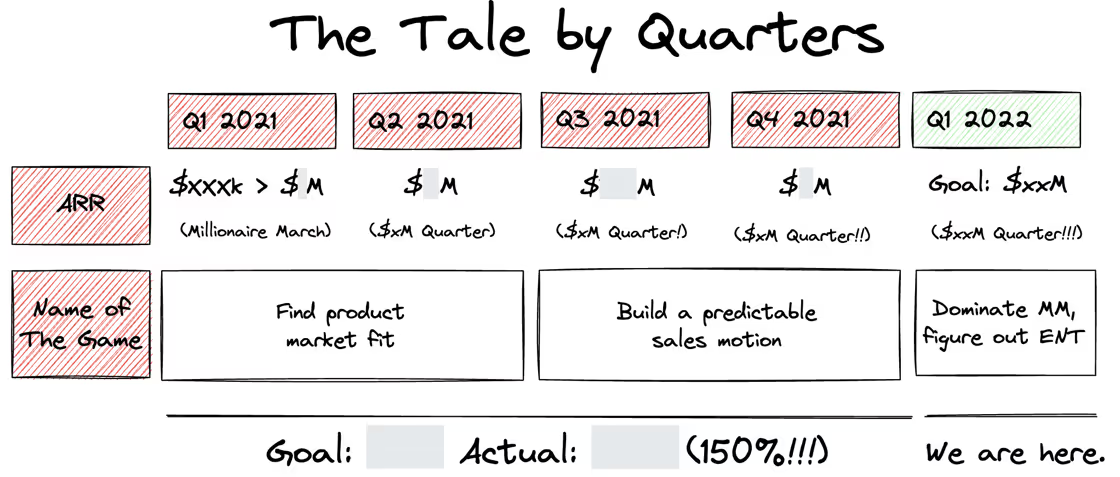How I Run Monday Morning Meetings as a VP of Sales
The Monday Morning Meeting (MMM) in sales can be one of two things:
- A way to waste 30 minutes and put all of your reps to sleep
- The meeting that gets your reps charging into the week
The goal of this newsletter is for your sales all-hands to be the latter.
My reps would often leave the Monday Morning Meeting saying: I'm ready to run through a brick wall now Mondo. That's because it's my job to sell my team on why they have the most important job in the company every single week.
There are 4 parts of every Monday Morning Meeting, starting at 9am sharp:
- GOOD MORNING (and PSAs): Wake people up + share org-wide updates.
- Mondo's Mic Drop: Sell my team.
- Manager Metrics: Start the week with prospecting.
- The 5-Minute Squeeze: One rep trains the whole team.
Good morning. Let's dive in.
Part 1: GOOD MORNING (and PSAs)

Inside of every VP of Sales / CRO lives a young AE who used to show up to work fired up everyday. For some reason when they reached the top, that person died inside. So now they show about as much enthusiasm as I do when I'm licking a stamp at my local USPS.
So I took inspiration from my high school history teacher. No matter how early, how boring the topic, or how disengaged the students were... he'd belt GOOOOOOOD MORNING for a solid 10 seconds straight until it got laughably obnoxious.
His "Good Morning" became so famous that it was written up in the LA Times. A student asked him once about it and he said something along the lines of:
You think I'm excited to talk about "history" every day? Of course not. But if I can't find the silver linings in the day, how can I expect that from my students?
The "Good Morning" you hear on every podcast is the exact same good morning that I belted in every MMM (except I'd hold it for a solid 10 seconds). To the point at which the team nearly voted to rename President's Club to "The Good Morning Summit" (which almost actually happened).
I get it. It sounds dumb. It's meant to be. If you prefer a PPT and a melatonin, go for it.
From there, I get all "corporate PSAs" before the 10 minute mark. If marketing, product, or anyone else needs to give an announcement, it's gotta be under 10.
Because now, it's onto the good stuff.
Part 2: Mondo's Mic Drop

Once the PSAs are over, the visitors leave the room and I take the mic again.
Now it's time for me to sell my team. While this changes every week, the general of information goes from
- What this means for the company (tale by quarters): I'd always pick 1 theme of the quarter (ie: improving big deal process), why it's different from the last quarter, and what it means for the entire company if we can evolve as a team together.
- What this means for the team (current, forecast, gap): Where are we and what's required for us to close the gap (ie: generating XX deals per rep early in the quarter, staying tight on vendor review later in the quarter).
- What this means for you (leaderboard): Where every rep stands, what they're forecasted to hit, and how that contributes to the broader team number.
The biggest mistake that leaders make is when it feels too abstract for the reps. I remember a past boss would show a $25M number and I carried a $50k quota. You have to find a way to show your reps how every single drop in the bucket matters.
That happens when you call out key deals, pull up the leaderboard and highlight climbing reps who might not get as much attention. Boil down what every single rep needs to do to hit the bigger number.
And try to keep the month or quarter to a single theme. If the focus is improving sales process on big deals, cover it every week. Hit on big deal process in every deal review. Hit big deal process in every tape review. Communicate 1 thing in 100 places.
Part 3: Manager Metrics

From here, we pass the baton to the managers. Managers meet with their pod to drill into activity metrics and get commitments at 8:30am before the org-wide MMM at 9:00am.
Managers review controllable leading indicators, not lagging indicators. I reviewed revenue previously and the goal of the MMM is to drive top of funnel behavior. Leave the down-funnel activity to the forecasting meeting.
Plot all reps with 5 columns in your spreadsheet (pictured above):
- Accounts worked
- Cold calls (or the lead activity metric you care about most)
- Meetings set
- Pipe generated (month-to-date)
- Commitment (for next week)
The goal is not to perfectly track every metric, but to have a few consistent prospecting activities that are shared for public accountability.
Reps are expected to fill this out (yes, manually) to reflect on the week and make a commitment to doing something controllable next week.
From there, managers highlight one rep of the week, with my golden 3 criteria being 25 net new accounts worked, 200 dials, and 3 meetings booked.
Change this for your sales cycle, but that worked for us in a mid-market sales motion. If there's a tie, let the pod vote for the true winner.
Part 4: The Five Minute Squeeze

Notice: We started with the org. Then me (the VP). Then the managers. And finally... the baton is handed to the reps.
In the early stages, we didn't have all the time to build fancy enablement programs. So built our playbooks 5 minutes at a time, every week.
The reality is the best secrets live in the field with your reps. So pick 1 topic every week and ask a rep to break it down on the spot. The ground rules:
- It cannot take longer than 5 minutes
- It must be tactical
- It's encouraged be ugly (no high production value)
Let them share their secrets with the team while you take live notes in front of everyone and help structure their thoughts.
Past topics that have went well include: how to drive legal faster, how to drive timeline, how to deal with a prospect that seems unqualified, how to handle X objection.
From there, save your 5-minute squeeze docs into a master folder (bucketed by prospecting, discovery, process) and now you've got one extra playbook page every week.
***
That's a wrap folks! And if you liked this, you'll love the episode we did on How To Train Your Team that Mark Kosoglow and I recorded on the leadership podcast.
Follow the link below to bookmark this episode for your next commute:



.avif)













